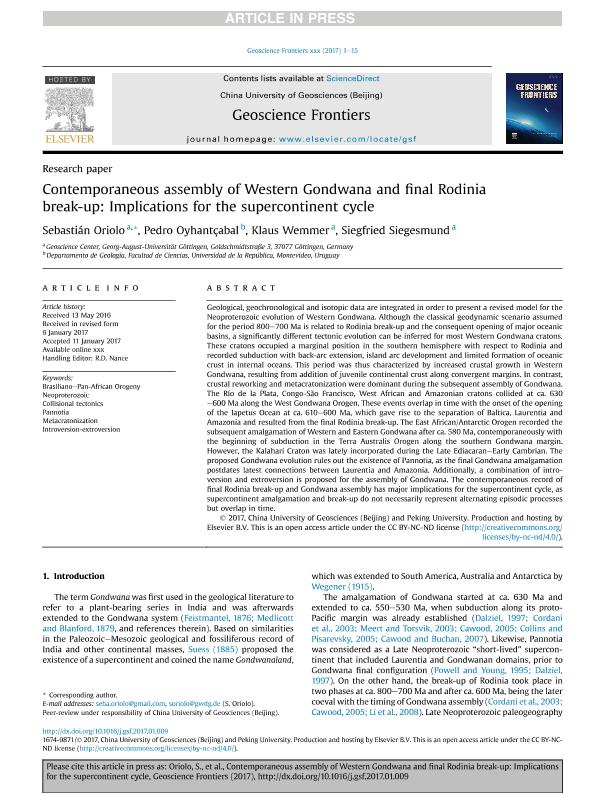Artículo
Contemporaneous assembly of Western Gondwana and final Rodinia break-up: Implications for the supercontinent cycle
Fecha de publicación:
11/2017
Editorial:
Elsevier Science
Revista:
Geoscience Frontiers
ISSN:
1674-9871
Idioma:
Inglés
Tipo de recurso:
Artículo publicado
Clasificación temática:
Resumen
Geological, geochronological and isotopic data are integrated in order to present a revised model for the Neoproterozoic evolution of Western Gondwana. Although the classical geodynamic scenario assumed for the period 800–700 Ma is related to Rodinia break-up and the consequent opening of major oceanic basins, a significantly different tectonic evolution can be inferred for most Western Gondwana cratons. These cratons occupied a marginal position in the southern hemisphere with respect to Rodinia and recorded subduction with back-arc extension, island arc development and limited formation of oceanic crust in internal oceans. This period was thus characterized by increased crustal growth in Western Gondwana, resulting from addition of juvenile continental crust along convergent margins. In contrast, crustal reworking and metacratonization were dominant during the subsequent assembly of Gondwana. The Río de la Plata, Congo-São Francisco, West African and Amazonian cratons collided at ca. 630–600 Ma along the West Gondwana Orogen. These events overlap in time with the onset of the opening of the Iapetus Ocean at ca. 610–600 Ma, which gave rise to the separation of Baltica, Laurentia and Amazonia and resulted from the final Rodinia break-up. The East African/Antarctic Orogen recorded the subsequent amalgamation of Western and Eastern Gondwana after ca. 580 Ma, contemporaneously with the beginning of subduction in the Terra Australis Orogen along the southern Gondwana margin. However, the Kalahari Craton was lately incorporated during the Late Ediacaran–Early Cambrian. The proposed Gondwana evolution rules out the existence of Pannotia, as the final Gondwana amalgamation postdates latest connections between Laurentia and Amazonia. Additionally, a combination of introversion and extroversion is proposed for the assembly of Gondwana. The contemporaneous record of final Rodinia break-up and Gondwana assembly has major implications for the supercontinent cycle, as supercontinent amalgamation and break-up do not necessarily represent alternating episodic processes but overlap in time.
Archivos asociados
Licencia
Identificadores
Colecciones
Articulos(IGEBA)
Articulos de INSTITUTO DE GEOCIENCIAS BASICAS, APLICADAS Y AMBIENTALES DE BS. AS
Articulos de INSTITUTO DE GEOCIENCIAS BASICAS, APLICADAS Y AMBIENTALES DE BS. AS
Citación
Oriolo, Sebastián; Oyhantçabal, Pedro; Wemmer, Klaus; Siegesmund, Siegfried; Contemporaneous assembly of Western Gondwana and final Rodinia break-up: Implications for the supercontinent cycle; Elsevier Science; Geoscience Frontiers; 8; 6; 11-2017; 1431-1445
Compartir
Altmétricas




